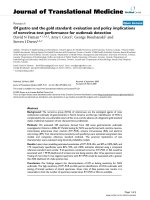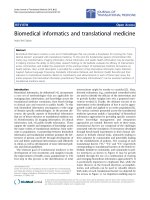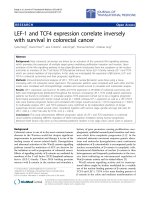Báo cáo hóa học: " q-Bernoulli numbers and q-Bernoulli polynomials revisited" docx
Bạn đang xem bản rút gọn của tài liệu. Xem và tải ngay bản đầy đủ của tài liệu tại đây (228.7 KB, 8 trang )
RESEARC H Open Access
q-Bernoulli numbers and q-Bernoulli polynomials
revisited
Cheon Seoung Ryoo
1*
, Taekyun Kim
2
and Byungje Lee
3
* Correspondence:
1
Department of Mathematics,
Hannam University, Daejeon 306-
791, Korea
Full list of author information is
available at the end of the article
Abstract
This paper performs a further investigation on the q-Bernoulli numbers and q-
Bernoulli polynomials given by Acikgöz et al. (Adv Differ Equ, Article ID 951764, 9,
2010), some incorrect properties are revised. It is point out that the generating
function for the q-Bernoulli numbers and polynomials is unreasonable. By using the
theorem of Kim (Kyushu J Math 48, 73-8 6, 1994) (see Equation 9), some new
generating functions for the q-Bernoulli numbers and polynomials are shown.
Mathematics Subject Classification (2000) 11B68, 11S40, 11S80
Keywords: Bernoulli numbers and polynomials, q-Bernoulli numbers and polyno-
mials, q-Bernoulli numbers and polynomials
1. Introduction
As well-known definition, the Bernoulli polynomials are given by
t
e
t
− 1
e
xt
= e
B(x)t
=
∞
n
=
0
B
n
(x)
t
n
n!
,
(see [1-4]),
with usual convention about replacing B
n
(x)byB
n
(x). In the special case, x =0,B
n
(0)
= B
n
are called the nth Bernoulli numbers.
Let us assume that q Î ℂ with |q| <1 as an indeterminate. The q-number is defined by
[x]
q
=
1 − q
x
1 −
q
,
(see [1-6]).
Note that lim
q®1
[x]
q
= x.
Since Carlitz brought out the concept of the q-extension of Bernoulli numbers and
polynomials, many mathematici ans have studied q-Bernoulli numb ers and q-Bernoul li
polynomials ( see [1,7,5,6,8-12]). Recently, Acikgöz, Erdal, and Araci have studied to a
new approach to q-Berno ulli numbers and q-Bernoulli polynomials related to q-Bern-
stein poly nom ials (see [7]). But, their gener ati ng function is unreasonable. The wrong
properties are indicated by some counter-examples, and they are corrected.
It is point out that Acikgöz, Erdal and Araci’s generating function for q-Bernoulli
numbers and polynomi als is unreasonable by count er examples, then the new generat-
ing function for the q-Bernoulli numbers and polynomials are given.
Ryoo et al . Advances in Difference Equations 2011, 2011:33
/>© 2011 Ryoo et al; licensee Springer. This is an Open Access article distributed under the terms of the Creative Commons Attribution
License (http://creat ivecommons.org/licenses/b y/2. 0), which permits unrestricted use, distribution, and reproduction in any medium,
provided the original work is prope rly cited.
2. q-Bernoulli numbers and q-Bernoulli polynomials revisited
In this section, we perform a further investigation on the q-Bernoulli numbers and q-
Bernoulli polynomials given by Acikgöz et al. [7], some incorrect properties are revised.
Definition 1 (Acikgöz et al. [7]). For q Î ℂ with |q| <1, let us define q-Bernoulli
polynomials as follows:
D
q
(t, x)=−t
∞
y
=0
q
y
e
[x+y]
q
t
=
∞
n=0
B
n,q
(x)
t
n
n!
, where —t +logq—¡2π
.
(1)
In the special case, x =0,B
n,q
(0) = B
n,q
are called the nth q-Bernoulli numbers.
Let D
q
(t,0)=D
q
(t). Then
D
q
(t)=−t
∞
y
=0
q
y
e
[y]
q
t
=
∞
n=0
B
n,q
t
n
n!
.
(2)
Remark 1. Defini tion 1 is unreasonable, since it is not the generating function of q-
Bernoulli numbers and polynomials.
Indeed, by (2), we get
D
q
(t, x)=−t
∞
y=0
q
y
e
[x+y]
q
t
= −t
∞
y=0
q
y
e
[x]
q
t
e
q
x
[y]
q
t
=
⎛
⎝
−
q
x
t
q
x
∞
y=0
q
y
e
q
x
[y]
q
t
⎞
⎠
e
[x]
q
t
=
1
q
x
e
[x]
q
t
D
q
(q
x
t)
=
∞
m=0
[x]
m
q
m!
t
m
∞
l=0
q
(l−1)x
B
l,q
l!
t
l
=
∞
n=0
n
l=0
n
l
[x]
n−l
q
q
(l−1)x
B
l,q
t
n
n!
.
(3)
By comparing the coefficients on the both sides of (1) and (3), we obtain the follow-
ing equation
B
n,q
(x)=
n
l
=
0
n
l
[x]
n−l
q
q
(l−1)x
B
l,q
.
(4)
From (1), we note that
D
q
(t, x)=−t
∞
y=0
q
y
e
[x+y]
q
t
=
∞
n=0
⎛
⎝
−t
∞
y=0
q
y
[x + y]
n
q
⎞
⎠
t
n
n!
= −
∞
n=0
⎛
⎝
n +1
(1 − q)
n
n
l=0
n
l
(−1)
l
q
lx
∞
y=0
q
(l+1)y
⎞
⎠
t
n+1
(n +1)!
=
∞
n=1
−n
(1 − q)
n−1
n−1
l
=
0
n − 1
l
(−1)
l
q
lx
1
1 − q
l+1
t
n
n!
.
(5)
Ryoo et al . Advances in Difference Equations 2011, 2011:33
/>Page 2 of 8
By comparing the coefficients on the both sides of (1) and (5), we obtain the follow-
ing equation
B
0,q
=0,
B
n,q
=
−n
(1 − q)
n−1
n−1
l
=
0
n − 1
l
(−1)
l
q
lx
1
1 − q
l+1
if n > 0
.
(6)
By (6), we see that Definition 1 is unreasonable because we cannot derive Bernoulli
numbers from Definition 1 for any q.
In particular, by (1) and (2), we get
qD
q
(t ,1)− D
q
(t )=t
.
(7)
Thus, by (7), we have
qB
n,q
(1) − B
n,q
=
1, if n =1,
0, if n > 1
,
(8)
and
B
n,q
(1) =
n
l
=
0
n
l
q
l−1
B
l,q
.
(9)
Therefore, by (4) and (6)-(9), we see that the following three theorems are incorrect.
Theorem 1 (Acikgöz et al. [7]). For n Î N*, one has
B
0,q
=1, q(qB +1)
n
− B
n,q
=
1, if n =0,
0, if n > 0
.
Theorem 2 (Acikgöz et al. [7]). For n Î N*, one has
B
n,q
(x)=
n
l
=
0
n
l
q
lx
B
l,q
[x]
n−l
q
.
Theorem 3 (Acikgöz et al. [7]). For n Î N*, one has
B
n,q
(x)=
1
(1 − q)
n
n
l
=
0
n
l
(−1)
l
q
lx
l +1
[l +1]
q
.
In [7], Acikgöz, Erdal and Araci derived some results by using Theorems 1-3. Hence,
the other results are incorrect.
Now, we redefine the generating function of q-Bernoulli numbers and polynomials
and correct its wrong properties, and rebuild the theorems of q-Bernoulli numbers and
polynomials.
Redefinition 1.Forq Î ℂ with |q| <1, let us define q-Bernoulli polynomials as fol-
lows:
F
q
(t , x)=−t
∞
m=0
q
2m+x
e
[x+m]
q
t
+(1− q)
∞
m=0
q
m
e
[x+m]
q
t
=
∞
n
=
0
β
n,q
(x)
t
n
n!
, where —t +logq— < 2π
.
(10)
Ryoo et al . Advances in Difference Equations 2011, 2011:33
/>Page 3 of 8
In the special case, x =0,b
n,q
(0) = b
n,q
are called the nth q-Bernoulli numbers.
Let F
q
(t,0)=F
q
(t). Then we have
F
q
(t )=
∞
n=0
β
n,q
t
n
n!
= −t
∞
m
=
0
q
2m
e
[m]
q
t
+(1− q)
∞
m
=
0
q
m
e
[m]
q
t
.
(11)
By (10), we get
β
n,q
(x)=−n
∞
m=0
q
2m+x
[x + m]
n−1
q
+(1− q)
∞
m=0
q
m
[x + m]
n
q
=
−n
(1 − q)
n−1
n−1
l=0
n − 1
l
(−1)
l
q
(l+1)x
(1 − q
l+2
)
+(1− q)
∞
m=0
q
m
[x + m]
n
q
=
1
(1 − q)
n
n
l
=
0
n
l
(−1)
l
q
lx
l +1
[l +1]
q
.
(12)
By (10) and (11), we get
F
q
(t, x)=e
[x]
q
t
F
q
(q
x
t)
=
∞
m=0
[x]
m
q
t
m
m!
∞
l=0
β
l,q
l!
q
lx
t
l
=
∞
n=0
n
l=0
q
lx
β
l,q
[x]
n−l
q
n!
l!(n − l)!
t
n
n!
=
∞
n=0
n
l
=
0
n
l
q
lx
β
l,q
[x]
n−l
q
t
n
n!
.
(13)
Thus, by (12) and (13), we have
β
n,q
(x)=
n
l=0
n
l
q
lx
β
l,q
[x]
n−l
q
= −n
∞
m
=
0
q
m
[x + m]
n−1
q
+(1− q)(n +1)
∞
m
=
0
q
m
[x + m]
n
q
.
(14)
From (10) and (11), we can derive the following equation:
qF
q
(t ,1)− F
q
(t )=t +(q − 1)
.
(15)
By (15), we get
qβ
n,q
(1) − β
n,q
=
⎧
⎨
⎩
q − 1, if n =0,
1, if n =1,
0ifn > 1
.
(16)
Ryoo et al . Advances in Difference Equations 2011, 2011:33
/>Page 4 of 8
Therefore, by (14) and (15), we obtain
β
0,q
=1,q(qβ
q
+1)
n
− β
n,q
=
1, if n =1,
0if n > 1
,
(17)
with the usual convention about replacing
β
n
q
by b
n,q
.
From (12), (14) and (16), Theorems 1-3 are revised by the following Theorems 1’-3’.
Theorem 1’. For n Î ℤ
+
, we have
β
0,q
=1, and q(qβ
q
+1)
n
− β
n,q
=
1, if n =1,
0if n > 1
.
Theorem 2’. For n Î ℤ
+
, we have
β
n,q
(x)=
n
l
=
0
n
l
q
lx
β
l,q
[x]
n−l
q
.
Theorem 3’. For n Î ℤ
+
, we have
β
n,q
(x)=
1
(1 − q)
n
n
l
=
0
n
l
(−1)
l
q
lx
l +1
[l +1]
q
.
From (10), we note that
F
q
(t , x)=
1
[d]
q
d−1
a
=
0
q
a
F
q
d
[d]
q
t,
x + a
d
, d ∈
N
.
(18)
Thus, by (10) and (18), we have
β
n,q
(x)=[d]
n−1
q
d
−1
a
=
0
q
a
β
n,q
d
x + a
d
, n ∈
Z
+
.
For d Î N,letc be Dirichlet’s character with conductor d. Then, we consider the
generalized q-Bernoulli polynomials attached to c as follows:
F
q,χ
(t , x)=−t
∞
m=0
χ(m)q
2m+x
e
[x+m]
q
t
+(1− q)
∞
m=0
χ(m)q
m
e
[x+m]
q
t
=
∞
n
=
0
β
n,χ,q
(x)
t
n
n!
.
In the special case, x =0,b
n,c,q
(0) = b
n,c,q
are called the nth generalized Carlitz q-
Bernoulli numbers attached to c (see [8]).
Let F
q,c
(t,0)=F
q,c
(t). Then we have
F
q,χ
(t )=−t
∞
m=0
χ(m)q
2m
e
[m]
q
t
+(1− q)
∞
m=0
χ(m)q
m
e
[m]
q
t
=
∞
n
=
0
β
n,χ,q
t
n
n!
.
(20)
Ryoo et al . Advances in Difference Equations 2011, 2011:33
/>Page 5 of 8
From (20), we note that
β
n,χ,q
= −n
∞
m=0
q
2m
χ(m)[m]
n−1
q
+(1− q)
∞
m=0
q
m
χ(m)[m]
n
q
= −n
d−1
a=0
∞
m=0
q
2a+2dm
χ(a + dm)[a + dm]
n−1
q
+
d−1
a=0
∞
m=0
q
a+dm
χ(a + dm)[a + dm]
n
q
=
d−1
a=0
χ(a)q
a
−n
(1 − q)
n−1
n−1
l=0
n − 1
l
(−1)
l
q
(l+1)a
(1 − q
d(l+2)
)
+(1− q)
d−1
a=0
χ(a)q
a
1
(1 − q)
n
n
l=0
n
l
(−1)
l
q
la
(1 − q
d(l+1)
)
=
d−1
a=0
χ(a)q
a
−n
(1 − q)
n−1
n−1
l=0
n − 1
l
(−1)
l
q
(l+1)a
(1 − q
d(l+2)
)
+
d−1
a=0
χ(a)q
a
1
(1 − q)
n−1
n
l=0
n
l
(−1)
l
q
la
(1 − q
d(l+1)
)
=
d−1
a=0
χ(a)q
a
1
(1 − q)
n−1
n
l=0
n
l
(−1)
l
q
la
l
(1 − q
d(l+1)
)
+
d−1
a=0
χ(a)q
a
1
(1 − q)
n−1
n
l=0
n
l
(−1)
l
q
la
(1 − q
d(l+1)
)
=
d−1
a=0
χ(a)q
a
1 − q
(1 − q)
n
n
l
=
0
n
l
(−1)
l
q
la
l +1
1 − q
d(l+1)
.
Therefore, by (20) and (21), we obtain the following theorem.
Theorem 4. For n Î ℤ
+
, we have
β
n,χ,q
=
d−1
a=0
χ(a)q
a
1
(1 − q)
n
n
l=0
n
l
(−1)
l
q
la
l +1
[d(l +1)]
q
= −n
∞
m
=
0
χ(m)q
m
[m]
n−1
q
+(1− q)(1 + n)
∞
m
=
0
χ(m)q
m
[m]
n
q
,
and
β
n,χ,q
(x)=−n
∞
m
=
0
χ(m)q
m
[m + x]
n−1
q
+(1− q)(1 + n)
∞
m
=
0
χ(m)q
m
[m + x]
n
q
.
From (19), we note that
F
q,χ
(t , x)=
1
[d]
q
d
−1
a
=
0
χ(a)q
a
F
q
d
[d]
q
t,
x + a
d
.
(22)
Thus, by (22), we obtain the following theorem.
Ryoo et al . Advances in Difference Equations 2011, 2011:33
/>Page 6 of 8
Theorem 5. For n Î ℤ
+
, we have
β
n,χ,q
(x)=[d]
n−1
q
d−1
a
=
0
χ(a)q
a
β
n,q
d
x + a
d
.
For s Î ℂ, we now consider the Mellin transform for F
q
(t, x) as follows:
1
(s)
∞
0
F
q
(−t, x)t
s−2
dt =
∞
m=0
q
2m+x
[m + x]
s
q
+
1 − q
s − 1
∞
m=0
q
m
[m + x]
s−1
q
,
(23)
where x ≠ 0, -1, -2,
From (23), we note that
1
(s)
∞
0
F
q
(−t, x)t
s−2
dt
=
∞
m
=
0
q
m
[m + x]
s
q
+(1− q)
2 − s
s − 1
∞
m
=
0
q
m
[m + x]
s−1
q
,
(24)
where s Î ℂ, and x ≠ 0, -1, -2,
Thus, we define q-zeta function as follows:
Definition 2. For s Î ℂ, q-zeta function is defined by
ζ
q
(s, x)=
∞
m
=
0
q
m
[m + x]
s
q
+(1− q)
2 − s
s − 1
∞
m
=
0
q
m
[m + x]
s−1
q
, Re(s) > 1
,
where x ≠ 0, -1, -2,
By (24) and Definition 2, we note that
ζ
q
(1 − n, x)=(−1)
n−1
β
n,q
(x)
n
, n ∈ N
.
Note that
lim
q
→1
ζ
q
(1 − n, x)=−
B
n
(x)
n
,
where B
n
(x) are the nth ordinary Bernoulli polynomials.
Acknowledgements
The authors express their gratitude to the referee for his/her valuable comments.
Author details
1
Department of Mathematics, Hannam University, Daejeon 306-791, Korea
2
Division of General Education-Mathematics,
Kwangwoon University, Seoul 139-701, Korea
3
Department of Wireless Communications Engineering, Kwangwoon
University, Seoul 139-701, Korea
Authors’ contributions
All authors contributed equally to the manuscript and read and approved the finial manuscript.
Competing interests
The authors declare that they have no competing interests.
Received: 26 February 2011 Accepted: 18 September 2011 Published: 18 September 2011
References
1. Kim, T: On explicit formulas of p-adic q-L-functions. Kyushu J. Math. 48,73–86 (1994). doi:10.2206/kyushujm.48.73
Ryoo et al . Advances in Difference Equations 2011, 2011:33
/>Page 7 of 8
2. Kim, T: On p-adic q-L-functions and sums of powers. Discrete Math. 252, 179–187 (2002). doi:10.1016/S0012-365X(01)
00293-X
3. Ryoo, CS: A note on the weighted q-Euler numbers and polynomials. Adv. Stud. Contemp. Math. 21,47–54 (2011)
4. Ryoo, CS: On the generalized Barnes type multiple q-Euler polynomials twisted by ramified roots of unity. Proc.
Jangjeon Math. Soc. 13, 255–263 (2010)
5. Kim, T: Power series and asymptotic series associated with the q-analogue of the two-variable p-adic L-function. Russ. J.
Math. Phys. 12,91–98 (2003)
6. Kim, T: q-Volkenborn integration. Russ. J. Math. Phys. 9, 288–299 (2002)
7. Acikgöz, M, Erdal, D, Araci, S: A new approach to q-Bernoulli numbers and q-Bernoulli polynomials related to q-
Bernstein polynomials. Adv. Differ. Equ 9 (2010). Article ID 951764
8. Kim, T, Rim, SH: Generalized Carlitz’s q-Bernoulli numbers in the p-adic number field. Adv. Stud. Contemp. Math. 2,9–19
(2000)
9. Ozden, H, Cangul, IN, Simsek, Y: Remarks on q-Bernoulli numbers associated with Daehee numbers. Adv. Stud.
Contemp. Math. 18,41–48 (2009)
10. Bayad, A: Modular properties of elliptic Bernoulli and Euler functions. Adv. Stud. Contemp. Math. 20, 389–401 (2010)
11. Kim, T: Barnes type multiple q-zeta function and q-Euler polynomials. J. Phys. A Math. Theor. 43, 255201 (2010).
doi:10.1088/1751-8113/43/25/255201
12. Kim, T: q-Bernoulli numbers and polynomials associated with Gaussian binomial coefficients. Russ. J. Math. Phys. 15,
51–57 (2008)
doi:10.1186/1687-1847-2011-33
Cite this article as: Ryoo et al.: q-Bernoulli numbers and q-Bernoulli polynomials revisited. Advances in Difference
Equations 2011 2011:33.
Submit your manuscript to a
journal and benefi t from:
7 Convenient online submission
7 Rigorous peer review
7 Immediate publication on acceptance
7 Open access: articles freely available online
7 High visibility within the fi eld
7 Retaining the copyright to your article
Submit your next manuscript at 7 springeropen.com
Ryoo et al . Advances in Difference Equations 2011, 2011:33
/>Page 8 of 8









